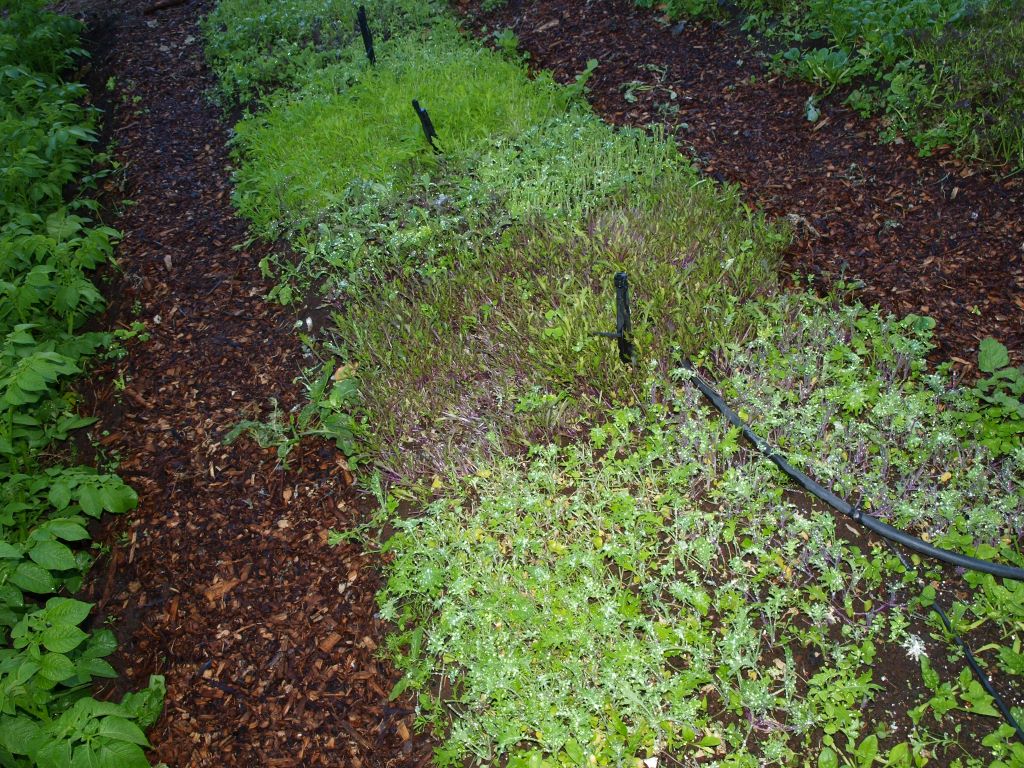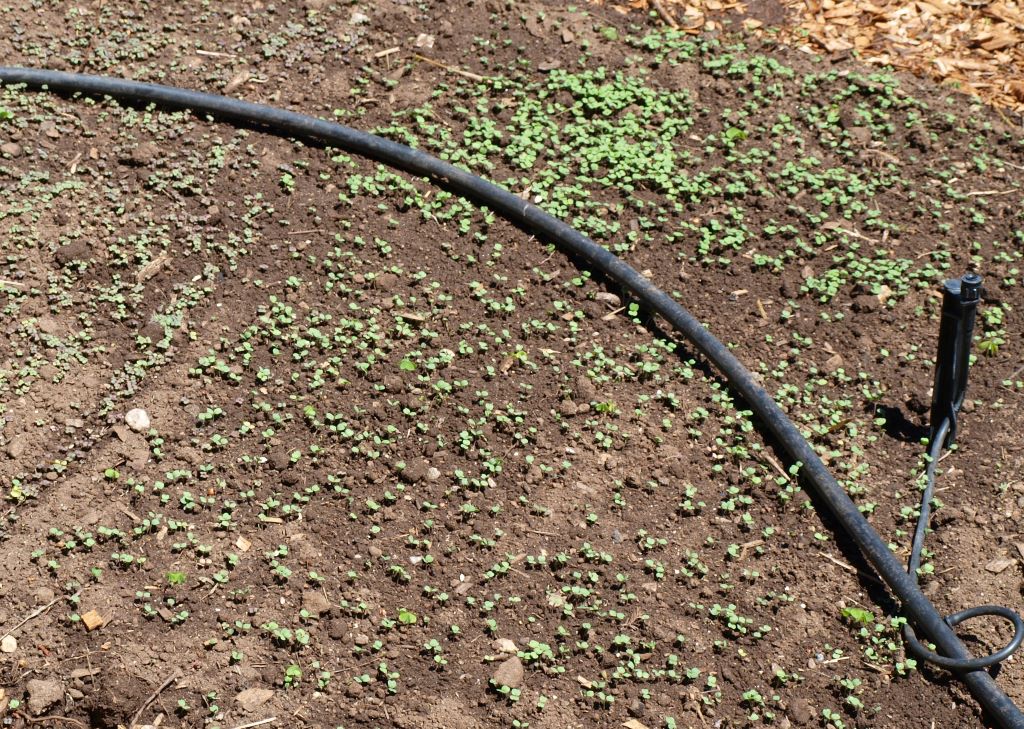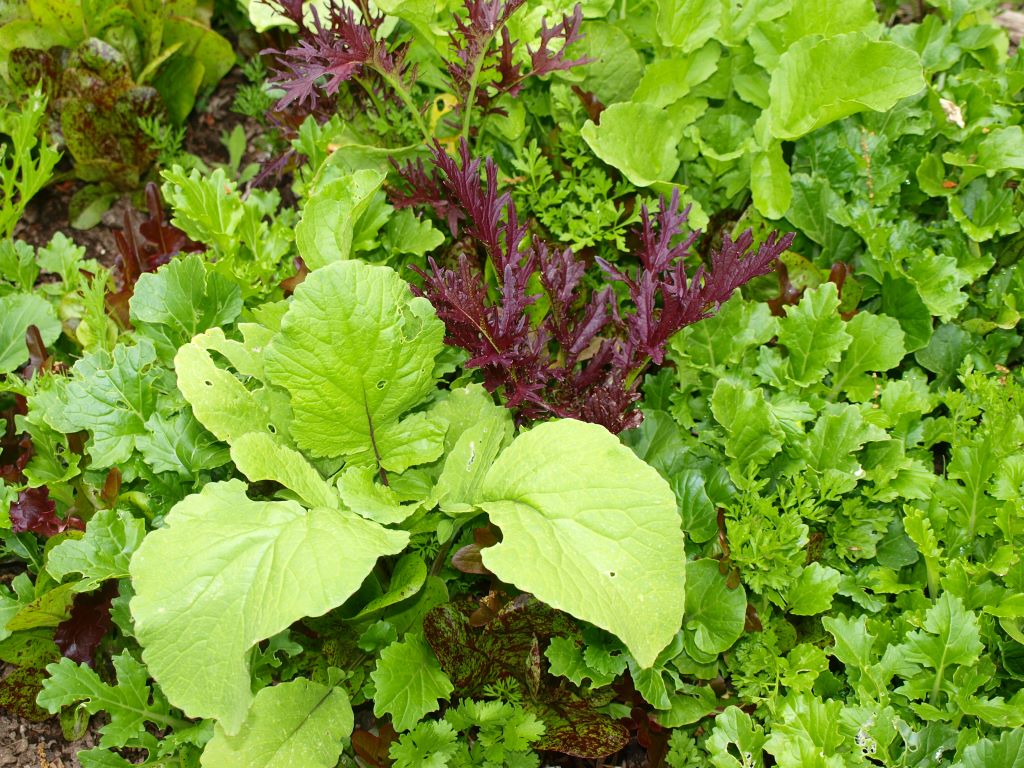Salad Mix / Mesclun
Introduction: The original salad mix was probably the French mesclun which originated in Provence and was a mix of lettuce, endive, arugala and chervil. In recent years the idea of salad mix has expanded to include a wide variety of different salad plants and commercial salad mixes are now very popular.
The clever part of growing salad mixes is the concept of sowing the plants so close together that they produce single leaves instead of hearted plants. The individual leaves are then cut as they reach suitable size. I have had such success with this method that I now grow most of my salad crops in this way.
Nutritional content: Salad greens are packed with vitamins (especially A and C), minerals and beneficial phytonutrients. We could all benefit from eating at least one salad every day.
Ease of growing: Few things are as easy to grow as salad, mix: it is about as close to foolproof gardening as you can get. It is certainly much simpler than growing a bunch of different plants. It is also fast, in some cases you can start harvesting within a couple of weeks.
Climate: The majority of common salad plants prefer cool, humid weather. If you choose the seeds yourself (rather than planting a pre-packaged mix) you can tailor your choice of plants and varieties to suit the climate. It is possible to create a mix that will do well in warmer situations too.
Crop use: I rate salad mix as an essential garden crop because of its high nutritional value, ease of growing and productivity. As far as I am concerned, no garden should be without its salad beds. This is a very productive way to use garden space and should be one of your highest priorities.

Soil
pH 6.0 to 7.0
The soil is called upon to produce a lot of foliage in a short time, so it should be fertile, fairly neutral, moisture retentive and well-drained.
Soil preparation: Raised beds are the best way to grow salad mixes, as they provide the ideal rich well-drained soil. They are also convenient in that you can simply plant a few square feet of bed every week or two, to keep a continuous supply coming.
Be generous in your fertilization program, starting by incorporating a 2˝ layer of compost into the top 6˝ of soil. You should also add seaweed, wood ashes and colloidal phosphate (or an organic fertilizer mix).
Planning
Which plants to use: You can buy packets of “salad mix” seed, but if you choose your own individual varieties you have more choices. You can decide the proportion of bland, sour, bitter, and different textures and colors and you can adapt it according to the growing season. You might create a warm weather mix and a cool weather mix, so you can keep the salad coming all through the growing season. You might also create a longer lasting mix by avoiding plants that bolt quickly. See Varieties for more on the choice of plants.
How much: Plant at least 2 sq ft of mixed salad greens per person at each planting. Of course exactly how much to plant depends upon how much salad you eat.
When: The season makes a big difference as to what you can grow in a salad mix. You have to adapt your growing methods (and the species of plants) to the weather.
Spring and fall: Most traditional salad plants do best in cool weather, so these are the easiest and the most productive growing times. Many of these plants are very hardy and can germinate at temperatures as low as 40ºF, so you can start them pretty early. You can use cloches or poly tunnels to warm the soil and speed germination and growth.
Summer: If you want to grow salad mix in summer heat, you have to be a bit more resourceful, but it is certainly possible. Bolting (the bane of summer salad growing) is less of a problem because the plants won’t be around long enough to get the chance.
In warm weather the biggest problem is that cool weather crops, such as lettuce, don’t germinate very well (if at all) at higher soil temperatures. You can get around this by pre-germinating them in the fridge as described in Lettuce. You can also search out more heat tolerant species and varieties.
Winter: In Europe cold tolerant varieties of salad greens were commonly grown under glass (cloches, cold frames, poly tunnels) in winter and this can work well, as most of them prefer cool weather.
They will take longer to mature at this time of year, so make bigger sowings (or do it inside in containers). Your protected winter salad beds will be the perfect vacation resort for slugs and snails to spend the winter, so watch out for them too.
You can also move indoors entirely and grow them in the greenhouse (or under lights) in flats or large trays. See Microgreens for more on indoor salad growing.
Succession sowing: Make a planting of salad mix every 1 – 3 weeks (depending upon how much you eat and how fast they grow – which in turn depends upon the weather and the soil). The default option is to simply sow a patch every 10 days or so. If you end up with more salad than you need it will encourage you to eat more, which is not a bad thing.

Where
You don’t need a lot of space to grow salad mix, because you get a lot of plants in a small area. In cool weather the plants will grow best with full sun, but can do okay with some shade (there is nothing to lose by trying). If you want to grow them in hot weather they will usually do better with some shade during the hottest part of the day.
Planting
Direct sowing: Salad mixes are almost always direct sown because you are dealing with so many plants, so closely spaced together, that transplanting would be impractical. There are two common ways of planting.
One way is to simply scatter (broadcast) the seed on the surface of the bed, so there is a seed every ½ – 1˝. Spread this out carefully so the mix is evenly distributed and cover it with a light sifting of soil (or a mix of soil and sifted compost). When doing this it is important to scatter the seed evenly, you don’t want bare patches and congested patches. If you are new to this you could practice scattering the seed on to a sheet or a large piece of cardboard.
The other method is to make shallow furrows ¼˝ deep and 3˝ apart. Plant into these at ½ – 1˝ spacing and then scrape the disturbed soil back into them.
You can sow different kinds of seed into the same area of bed. However it is important that the strongest growers don’t overwhelm the weaker ones, so make sure they have sufficient space (it helps to mix the seed up thoroughly before planting). You can also harvest judiciously to prevent this happening.
You can also plant each variety separately in its own short rows or block. This is better than mixing in many ways, because it allows you to compensate for different growth rates (some plants grow faster than others and will need planting more often). It also allows you to grow and harvest as much of each variety as you want.
Water immediately after planting to thoroughly wet the soil and give the seeds a good start.
After watering you might want to cover the bed with cardboard, row covers or shade cloth (this is better as you can water right through it). This will slow evaporation from the bed and so reduce the frequency of watering. It is important to remove this as soon as the seeds start to germinate though, otherwise they will elongate and become chlorotic in their search for light.
In many places you will have to protect the bed from birds, cats and other creatures. The usual way to do this is with bird netting draped over plastic hoops. I prefer to support the net with tunnels made from hog wire fencing.
Spacing: Careful spacing is important because you don’t want the plants to be too crowded. If you are broadcasting you want your seeds to be ½ – 1˝ apart (no wider and no closer). If you plant in rows you want ½ – 1˝ spacing in the rows, with 3˝ between the rows.
Care
The best salad material comes from plants that grow rapidly, so you need to make sure they have everything they need for good growth.
Thinning: Once all of the seeds have germinated you can start harvest / thinning, to give each plant enough room.
Weeding: The bed will need weeding when young, to ensure that weeds don’t take over before the salad plants get established.
Watering: There are a lot of plants taking water from a small volume of soil, so the beds must be kept evenly moist at all times. This is especially critical in summer. Of course you don’t want the soil to get waterlogged either, so be aware of what is happening.
Feeding: You may be able to speed up regrowth by watering the plants after harvest with a dilute liquid kelp. I prefer not to use my old compost tea standby on them, because they will be eaten fairly soon afterwards.
Problems
Pests and disease: Slugs and snails love salad mix and will eat the seedlings as they emerge. They can be hand picked at night, or you could surround the bed with some kind of barrier (such as a copper strip).
If insect pests become a problem you can grow your salad mix under row covers.
Birds also appreciate the tender succulent seedlings and they can be a problem in both cold and hot conditions. If so you may have to net the whole bed.
Bolting: If any plants bolt you should remove them immediately. They won’t produce anything edible (the flower stems are too small to be of any use) and are just taking up space. Remove them and you leave more room for neighboring plants.

Harvesting
When: You can start harvesting individual leaves when they are 2 – 3˝ tall, which takes about 3 – 4 weeks. This can continue for as long as the bed is producing a worthwhile amount, which depends upon the crop, variety and climate. Some plants can be harvested for a month, some for only a week or two. Generally you should expect to get at least 2 cuttings from a bed.
Salad mix is very perishable and for maximum nutrition and flavor it is best to harvest just before you are going to eat it. However it is often more convenient to harvest every few days and keep it in a plastic bag in the fridge until needed.
Commercial growers harvest early in the morning when the plants are at their coolest (heat is the enemy of salad mix).
How: I will describe three ways you can harvest the plants. You can use just one of these methods, but you get more flexibility by using a combination of all three.
You can cut whole small plants (or clumps of plants) with shears, leaving the bottom inch of stem behind to regenerate. This enables the plants to continue growing, so you can get a second (and sometimes even a third) harvest. This is often known as ‘cut and come again’, because the same plants are harvested more than once.
You can also pick the largest leaves from individual plants, to give you a longer harvest period.
Another alternative is to harvest entire plants and thereby thin overcrowded areas (do this strategically so you thin the most crowded areas first). By doing so you can slowly thin out most of the bed over time. The plants that remain can be allowed to get bigger.
You need to wash the salad before eating and to check for insects and unwanted weeds.
Storage: Salad mix doesn’t store well so it’s best to cut only as much as you need for the next meal. It will keep for a week in the refrigerator in a plastic bag, but it will slowly deteriorate.
Unusual growing ideas
Hot weather salads: Many plants that bolt quickly in hot weather might still be grown as a salad mix because you are harvesting the plants when they are little more than seedlings and they won’t have time to bolt.
There are also things you can do to cool down the summer salad bed. Start by putting it where it will be coolest, which usually means in light shade (under a trellis, or to the north side of trees, fences or your house), or make a sunshade of shade cloth or wooden lath. Water daily to keep the entire area cool and moist and to prevent the plants from developing very strong flavors. Misters work great to cool the plants and provide water. You should also look for varieties and species that don’t mind some heat.
Containers: Salad mix can be grown in containers, but I have dealt with that separately (see Micro-greens).
Ornamental use: A bed of salad mix is quite attractive (if temporary) and can be used for its ornamental effect. You can make patterns of different shapes, colors and textures.
Foraging; To bulk up the salad and make it more interesting, you can go around the garden gathering various edible leaves and flowers. These can be gathered without significant harm to any plants and leave the garden looking untouched. Throw in a few sprouts and edible flowers (see those separate sections) and you have a salad that not only taste great, but looks spectacular and is highly nutritious.
Seed Saving: Eventually any remaining plants will start to bolt. I sometimes allow a few of the most interesting types to grow up and set seed, as this supplies the seed that will be needed for growing next years salad mix.
Varieties
The ideal plants for a salad mix taste good (not too bitter or pungent), are tender and succulent, look good, germinate and grow quickly and don’t bolt easily. The choice of suitable plants will vary according to the growing conditions. Finding salad plants that tolerate hot or cold weather is more challenging than finding ones that grow well in mild temperatures.
When choosing plants, you will want a variety of flavors.
Bland: This is for the bulk of the salad. Lettuce is almost always the first choice, as there are so many kinds and they work so well. The best types of lettuce for this are the romaines, though leaf lettuce also works well. Usually you will have more than one variety in a mix.
Other bland green include amaranth, komatsuna, miners lettuce, spinach, chard and beet greens. Cornsalad is good too, but will probably need to be planted separately because it is fairly slow growing.
Pungent: Mustards are the most commonly used, because they so fast and easy to grow. Arugala is also popular, if you like its distinctive pungent flavor. Kale, green onion, garden cress, peppergrass, radish, land cress, Chinese cabbage and other Asian greens (mizuna, tatsoi and various mustards) are all possible options.
Bitter: Dandelion, chicory, fenugreek, radicchio (adds color too) endives (the curly frisee types are almost an essential because they add unique texture).
Sour: Sorrel
Succulent: Purslane is a great hot weather crop. Miners Lettuce does well in cool moist conditions.
Aromatic: Basil, green onion, chervil, cilantro, shiso and shungiku.
Wild plants and weeds: If you are creative (and know what you are doing) you can add a number of garden weeds to your mix, to bulk it up and add nutrition (and flavor).
Other plants: Of course you can add anything else that is edible in your garden. See Edible flowers in particular.
Cold tolerant: Cornsalad, Brassicas, chicory, Asian greens and some lettuce.
Heat tolerant: Mizuna, basil, amaranth, lambs quarter, purslane, chard, kale, collards, garden sorrel, New Zealand spinach and some lettuce.
Kitchen use
Combine your salad mix with some edible flowers and wild greens for the ultimate salad.
| Tahini salad dressing 4 tbsp tahini Juice of a lemon 1 tsp mustard 1 or 2 garlic cloves (crushed) 2 tbsp tamari ½ tsp pepper 2 tbsp water Mix everything together thoroughly and its ready. |










